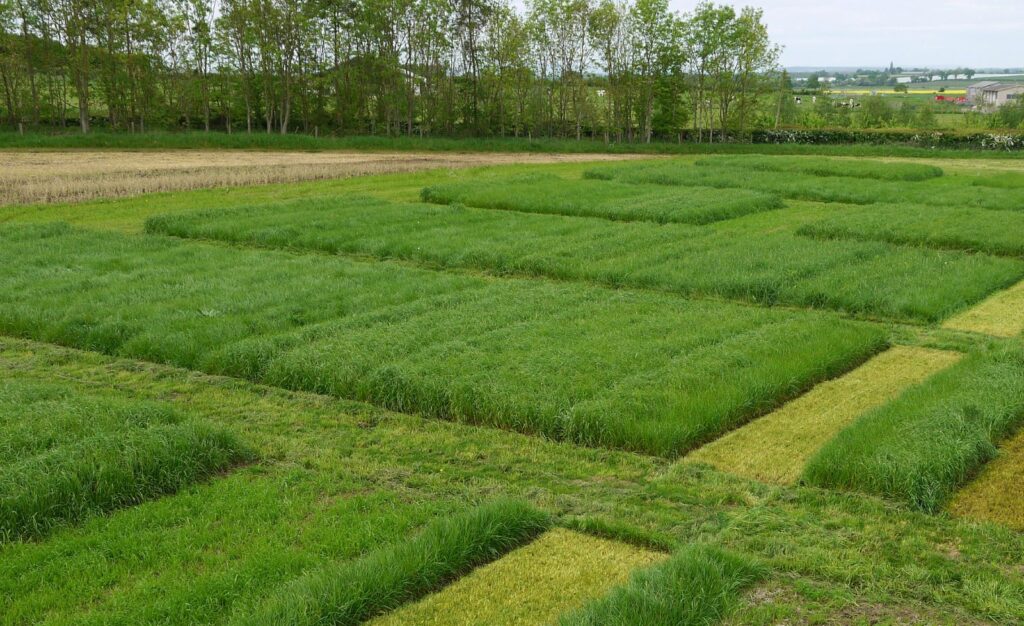Diversify grassland swards to reduce nitrogen use and boost yields
29th June 2023
Adding clover and herbs to the mix when reseeding not only reduces the need for bought-in fertiliser, but also provides grassland swards with a boost in dry matter yield, trials by ProCam’s Field Options division have shown.

The CERC trails at Harper Adams University have shown that the inclusion of clover and herbs at reseeding improves the overall DM and protein production of grassland leys.
The same study has also shown that including herbage seeds can improve the drought tolerance of grassland leys, with the added diversity they provide making leys eligible for current countryside stewardship schemes.
“Although bagged fertiliser prices have come down since the highs of 2022, there has been a continued resurgence in interest amongst livestock farmers looking to reintroduce nitrogen-fixing clover into their grassland rotations,” said Simon Montgomery of Field Options.
“However, to achieve good rates of germination and establishment, the introduction of new seedstock must be done at the correct timing, with evidence suggesting that the best results are achieved when clover and herbage seeds are drilled as part of a planned reseeding programme,” he added.
Trials carried out by Field Options at the Crop and Environment Research Centre (CERC) at Harper Adams University in Shropshire have demonstrated that red clover, white clover, and herbs such as plantain and chicory, introduced at seeding, can significantly improve the protein content and DM (dry matter) yield of forage, even when provided with modest levels of bagged nitrogen.
The response is even more dramatic when the same mixtures are managed without nitrogen.
The aim of the trial was to test the performance of various grassland mixtures by comparing grass and clover blends to leading hybrid and perennial ryegrass controls, Mr Montgomery explained.
“With four years of data captured, the trial has shown that the inclusion of white clover elevates dry matter production by 0.8t/ha/year for swards receiving 250kg/ha of synthetic nitrogen, while the addition of red and white clover gives an uplift of 0.8-2.5 tonnes per year. In both cases, the gains can easily be translated into savings on bought-in feed and improvements in milk and meat productivity.”
The trial also tested the yield response of the same mixtures when zero supplemental nitrogen was applied. Despite some initial challenges, the grass and clover combinations eventually surpassed the leading perennial ryegrass blend that received 250 kg/hectare of N.
Clover played a significant role in driving this yield increase, with white clover contributing over four tonnes of DM per hectare per year and red clover delivering more than 5.5 tonnes, Mr Montgomery said.
Drought tolerance and stewardship opportunities
Several of the mixtures tested also contained drought tolerant grasses or Boston Plantain and Puna II Chicory, which increased yields even further, particularly in the dry season of 2020, he continued.
“This performance boost can be accounted for by the deep rooting growth habit of these species which makes them more resilient to drought by enabling them to scavenge nutrients and moisture from deeper soil horizons.
“With ‘normal’ weather patterns becoming increasingly unreliable, and early summer droughts more commonplace, livestock producers should therefore give careful thought to the composition and make-up of their grass swards – not only to enhance overall productivity and forage quality, but also to safeguard against future weather-related pressures,” he stressed.
Incorporating clovers and herbs in grassland leys can unlock GS4 Countryside Stewardship payments in England and GFTE payments in Wales. Moreover, in mixed farming rotations, it can enhance soil structure and fertility for subsequent arable crops.

The deep-rooting nature of clover and herbs such as plantain and chicory makes grassland swards more tolerant of dry ground conditions.
However, Mr Montgomery advised growers to be aware that nitrogen fixed by clover is not immediately accessible to companion grasses, as clover utilizes the nitrogen for its own needs during the initial 9-12 months of its lifecycle. Therefore, the addition of clover should be considered as part of a comprehensive and long-term nutrient and sward management strategy.
“It’s also worth remembering that over-seeding clover into an existing sward can be challenging, with good establishment often hard to guarantee,” he added.
“A better option is to introduce clover as part of a reseeding strategy, although it may be necessary to control perennial weeds in the previous sward and to modify the cropping strategy by introducing a ‘cleaning’ break crop.
“Overall, however, it works out cheaper to sow a complete mixture of grasses and clover plus herbs in one hit compared to carrying out two separate seeding operations to introduce the components individually,” Mr Montgomery concluded.
For more information, get in touch with Field Options directly on 01544 262500 or via email at info@field-options.co.uk.
